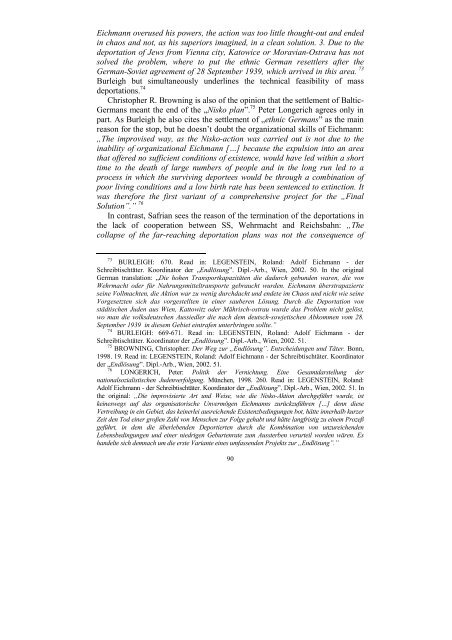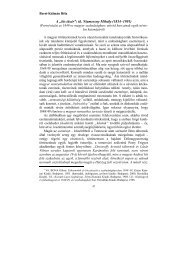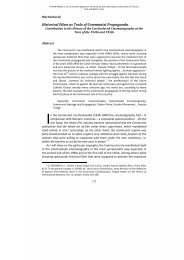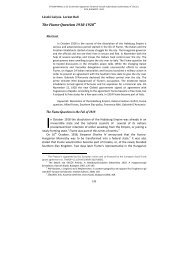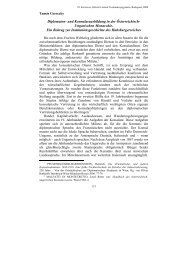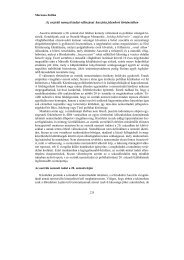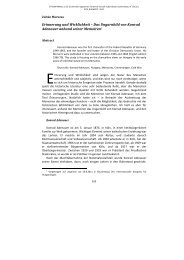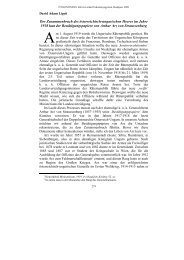The Molotov-Ribbentrop Pact - ELTE BTK Történelem Szakos Portál
The Molotov-Ribbentrop Pact - ELTE BTK Történelem Szakos Portál
The Molotov-Ribbentrop Pact - ELTE BTK Történelem Szakos Portál
Create successful ePaper yourself
Turn your PDF publications into a flip-book with our unique Google optimized e-Paper software.
Eichmann overused his powers, the action was too little thought-out and ended<br />
in chaos and not, as his superiors imagined, in a clean solution. 3. Due to the<br />
deportation of Jews from Vienna city, Katowice or Moravian-Ostrava has not<br />
solved the problem, where to put the ethnic German resettlers after the<br />
German-Soviet agreement of 28 September 1939, which arrived in this area. 73<br />
Burleigh but simultaneously underlines the technical feasibility of mass<br />
deportations. 74<br />
Christopher R. Browning is also of the opinion that the settlement of Baltic-<br />
Germans meant the end of the „Nisko plan”. 75 Peter Longerich agrees only in<br />
part. As Burleigh he also cites the settlement of „ethnic Germans” as the main<br />
reason for the stop, but he doesn’t doubt the organizational skills of Eichmann:<br />
„<strong>The</strong> improvised way, as the Nisko-action was carried out is not due to the<br />
inability of organizational Eichmann […] because the expulsion into an area<br />
that offered no sufficient conditions of existence, would have led within a short<br />
time to the death of large numbers of people and in the long run led to a<br />
process in which the surviving deportees would be through a combination of<br />
poor living conditions and a low birth rate has been sentenced to extinction. It<br />
was therefore the first variant of a comprehensive project for the „Final<br />
Solution”.” 76<br />
In contrast, Safrian sees the reason of the termination of the deportations in<br />
the lack of cooperation between SS, Wehrmacht and Reichsbahn: „<strong>The</strong><br />
collapse of the far-reaching deportation plans was not the consequence of<br />
73 BURLEIGH: 670. Read in: LEGENSTEIN, Roland: Adolf Eichmann - der<br />
Schreibtischtäter. Koordinator der „Endlösung”. Dipl.-Arb., Wien, 2002. 50. In the original<br />
German translation: „Die hohen Transportkapazitäten die dadurch gebunden waren, die von<br />
Wehrmacht oder für Nahrungsmitteltransporte gebraucht wurden. Eichmann überstrapazierte<br />
seine Vollmachten, die Aktion war zu wenig durchdacht und endete im Chaos und nicht wie seine<br />
Vorgesetzten sich das vorgestellten in einer sauberen Lösung. Durch die Deportation von<br />
städtischen Juden aus Wien, Kattowitz oder Mährisch-ostrau wurde das Problem nicht gelöst,<br />
wo man die volksdeutschen Aussiedler die nach dem deutsch-sowjetischen Abkommen vom 28.<br />
September 1939 in diesem Gebiet eintrafen unterbringen sollte.”<br />
74 BURLEIGH: 669-671. Read in: LEGENSTEIN, Roland: Adolf Eichmann - der<br />
Schreibtischtäter. Koordinator der „Endlösung”. Dipl.-Arb., Wien, 2002. 51.<br />
75 BROWNING, Christopher: Der Weg zur „Endlösung”. Entscheidungen und Täter. Bonn,<br />
1998. 19. Read in: LEGENSTEIN, Roland: Adolf Eichmann - der Schreibtischtäter. Koordinator<br />
der „Endlösung”. Dipl.-Arb., Wien, 2002. 51.<br />
76 LONGERICH, Peter: Politik der Vernichtung. Eine Gesamtdarstellung der<br />
nationalsozialistischen Judenverfolgung. München, 1998. 260. Read in: LEGENSTEIN, Roland:<br />
Adolf Eichmann - der Schreibtischtäter. Koordinator der „Endlösung”. Dipl.-Arb., Wien, 2002. 51. In<br />
the original: „Die improvisierte Art und Weise, wie die Nisko-Aktion durchgeführt wurde, ist<br />
keineswegs auf das organisatorische Unvermögen Eichmanns zurückzuführen […] denn diese<br />
Vertreibung in ein Gebiet, das keinerlei ausreichende Existenzbedingungen bot, hätte innerhalb kurzer<br />
Zeit den Tod einer großen Zahl von Menschen zur Folge gehabt und hätte langfristig zu einem Prozeß<br />
geführt, in dem die überlebenden Deportierten durch die Kombination von unzureichenden<br />
Lebensbedingungen und einer niedrigen Geburtenrate zum Aussterben verurteil worden wären. Es<br />
handelte sich demnach um die erste Variante eines umfassenden Projekts zur „Endlösung”.”<br />
90


